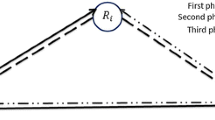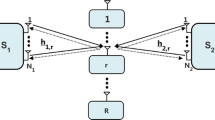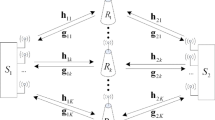Abstract
Two novel best-relay selection protocols, the jointing adaptive modulation max–min (AM-MM) protocol and the jointing adaptive modulation maximum harmonic mean (AM-MHM) protocol, are proposed for two-way opportunistic relaying systems with amplify-and-forward policy (TWOR-AF). By integrating the adaptive modulation with the conventional max–min (NonAM-MM) and maximum harmonic mean protocols, the effect of the modulation schemes used at both sources is exploited perfectly in the proposed AM-MM and AM-MHM protocols. The analytical expressions to the approximate upper bounds of overall average symbol error probability (SEP) for TWOR-AF systems with these different relay selection protocols are obtained through theoretic analysis. The numerical results demonstrate that the average SEP of TWOR-AF systems can be improved greatly when the proposed jointing adaptive modulation relay selection protocols are performed. Furthermore, in certain channel realizations, the adaptive modulation non-selection protocol outperforms the conventional NonAM-MM protocol in which the adaptive modulation is not integrated.





Similar content being viewed by others
References
Sendonaris, A., Erkip, E., & Aazhang, B. (2003). User cooperation diversity, part I: System description. IEEE Transactions on Communications, 51(11), 1927–1938.
Sendonaris, A., Erkip, E., & Aazhang, B. (2003). User cooperation diversity, part II: Implementation aspects and performance analysis. IEEE Transactions on Communications, 51(11), 1939–1948.
Atapattu, S., Jing, Y., Jiang, H., & Tellambura, C. (2010). Opportunistic relaying in two-way networks. In Proceedings of 5th international ICST conference on communications and networking in China, Beijing, China (pp. 1–8).
Oechtering, T. J., & Boche, H. (2008). Bidirectional regenerative half-duplex relaying using relay selection. IEEE Transactions on Wireless Communications, 7(5), 1879–1888.
Hwang, K. S., Ko, Y. C., & Alouini, M. S. (2009). Performance bounds for two-way amplify-and-forward relaying based on relay path selection. In Proceedings of IEEE 69th vehicular technology conference (VTC Spring 2009), Barcelona, Spain (pp. 1–5).
Rankov, B., & Wittneben, A. (2007). Spectral efficient protocols for half-duplex fading relay channels. IEEE Journal on Selected Areas in Communications, 25(2), 379–389.
Barua, B., Ngo, H. Q., & Shin, H. (2008). On the SEP of cooperative diversity with opportunistic relaying. IEEE Communications Letters, 12(10), 727–729.
Boujemâa, H. (2010). Exact symbol error probability of cooperative systems with partial relay selection. European Transactions on Telecommunications, 21(1), 79–85.
Song, L. (2011). Relay selection for two-way relaying with amplify-and-forward protocols. IEEE Transactions on Vehicular Technology, 60(4), 1954–1959.
Gong, Y., & Zhu, Y. (2011). A relay selection scheme based on the harmonic mean in two-way relay networks with physical layer network coding. In 2011 Global mobile congress (GMC), Shanghai, China (pp.1–5).
Guo, H., & Ge, J. H. (2010). Outage probability of two-way opportunistic amplify-and-forward relaying. Electronics Letters, 46(13), 918–919.
Zheng, J., Bai, B., & Li, Y. (2010). Outage-optimal opportunistic relaying for two-way amplify and forward relay channel. Electronics Letters, 46(8), 595–597.
Jia, X., Yang, L., & Fu, H. (2011). Tight performance bounds for two-way opportunistic amplify-and-forward wireless relaying networks with TDBC protocols. EURASIP Journal on Wireless Communications and Networking, 192, 1–8.
Koike-Akino, T., Popovski, P., & Tarokh, V. (2009). Optimized constellations for two-way wireless relaying with physical network coding. IEEE Journal on Selected Areas in Communications, 27(5), 773–787.
Koike-Akino, T., Popovski, P., & Tarokh, V. (2009). Adaptive modulation and network coding with optimized precoding in two-way relaying. In Proceeding of IEEE global telecommunications conference (GLOBECOM 2009), Hawaii, USA (pp. 1–6).
Zhi, H., Jia, X., Yang, L., & Fu, H. (2012). Comparison of average symbol error rate and optimal power allocation for two-way opportunistic relaying with amplify-and-forward protocol. In International journal of communication systems. published online in Wiley Online Library. http://onlinelibrary.wiley.com/doi/10.1002/dac.2366/pdf.
Krikidis, I., Thompson, J., McLaughlin, S., & Goertz, N. (2009). Max-min relay selection for legacy amplify-and-forward systems with interference. IEEE Transactions On Wireless Communications, 8(6), 3016–3027.
Xu, C., Ting-wai, S., Zhou, Q. F., & Lau, F. C. M. (2010). High-SNR analysis of opportunistic relaying based on the maximum harmonic mean selection criterion. IEEE Signal Processing Letters, 17(8), 719–722.
Jia, X., Yang, L., Fu, H., Feng, B., & Qi, Y. (2012). Two-way denoise-and-forward network coding opportunistic relaying with jointing adaptive modulation relay selection criterions. IET Communications, 6(2), 194–202.
Proakis, J. (2000). Digital communications (4th ed.). New York: McGraw-Hill.
Tao, C., Feifei, G., Ho, T., & Nallanathan, A. (2009). Distributed space-time coding for two-way wireless relay networks. IEEE Transactions on Signal Processing, 57(2), 658–671.
David, H. A., & Nagaraja, H. N. (2003). Order statistics (3rd ed.). New York: Wiley.
Gradshteyn, I. S., & Ryzhik, I. M. (2007). Table of integrals, series and products (7th ed.). New York: Academic.
Acknowledgments
This research is supported by the National Science and Technology Specific Project (2011ZX03005-004-003), the National Natural Science Foundation of China (61071090, 61171093), 973 Project of Jiangsu Province (BK2011027), Universities Natural Science Research Project of Jiangsu Province (11KJA510001), the project PAPD, and the Postgraduate Innovation Program of Scientific Research of Jiangsu Province (CXZZ11_0384).
Author information
Authors and Affiliations
Corresponding author
Appendix
Appendix
1.1 Appendix 1
Proof of Theorem 1
From expression (4), \(\gamma _{1k} =\frac{\rho ^{2}H_{1k} H_{2k} }{2\rho H_{1k} +\rho H_{2k} +1}\), \(\gamma _{2k} =\frac{\rho ^{2}H_{1k} H_{2k} }{\rho H_{1k} +2\rho H_{2k} +1}\), where \(H_{1k} =\left| {h_{1k} } \right|^{2}\) and \(H_{2k} =\left| {h_{2k} } \right|^{2}\) are exponentially distributed variables with distributed parameters \(\lambda _k \) and \(\mu _k \) respectively, we get \(H_{1k} \ge 0\),\(H_{2k} \ge 0\),\(\rho \ge 0\), and \(\gamma _{1k} \ge 0\), \(\gamma _{2k} \ge 0\). To analyze the PDF of \(\gamma _{1k} \) and \(\gamma _{2k} \), we should get the CDF of \(\gamma _{1k} \) and \(\gamma _{2k} \) at first. For \(\gamma >0\), we have
By dividing \(P\left(\frac{\rho ^{2}H_{1k} H_{2k} }{2\rho H_{1k} +\rho H_{2k} +1}>\gamma \right)\) into three cases, we can get
When \(H_{2k} <\frac{2\gamma }{\rho }\), we can get \(\frac{\rho H_{2k} \gamma +\gamma }{\rho ^{2}H_{2k} -2\rho \gamma }<0\). However we know that \(H_{1k} \ge 0\) from analysis mentioned before, so \(P(H_{2k} <\frac{2\gamma }{\rho },H_{1k} <\frac{\rho H_{2k} \gamma +\gamma }{\rho ^{2}H_{2k} -2\rho \gamma })=0\). We can also obtain that \(P(H_{2k} =\frac{2\gamma }{\rho },\frac{2\rho \gamma H_{1k} }{2\rho H_{1k} +2\gamma +1}>\gamma )=0\) due to \(\rho \ge 0\),\(H_{1k} \ge 0\),\(\gamma >0\). Thus we can get
Using the Equation (3.471.9) in [23], the integral in (38) can be obtained easily, leading to
where \(K_1 (\cdot )\) is the first order modified Bessel function of the second kind defined by (8.432.6) in [23]. As stated in [18], in high SNR, the modified Bessel function can be approximated as \(K_1 (z)\approx 1/z\). Thus, with high SNR approximation we have
For \(\gamma >0\), combining (40) and (36), we have
Taking the derivative of \(F_{\gamma _{1k} } (\gamma )\) with respect to \(\gamma \), we can get the approximately expression for the PDF of \(\gamma _{1k} \) at high SNR,
Similar to the analysis of \(f_{\gamma _{1k} } (\gamma )\), we can obtain the approximately expression for the PDF of \(\gamma _{2k} \) at high SNR, that is
\(\square \)
1.2 Appendix 2
Proof of Theorem 3
Using the definition \(w_k =\min (w_{1k} ,w_{2k} )\), the CDF of the \(w_k \) can be given by
Like analysis of expression (37), we can obtain
where \(A\cap B\) means intersection of set \(A\) and set \(B\). According to the solving process of equations \(\frac{w}{\rho {}\Delta M_2 }=\frac{2w}{\rho {}\Delta M_1 }\)and \(\frac{w\rho H_{1k} +w}{\rho ^{2}H_{1k} \Delta M_1 -2\rho w}=\frac{2w\rho H_{1k} +w}{\rho ^{2}H_{1k} \Delta M_2 -\rho w}\), expression (45) can be divided into three cases.
-
Case 1: for \(\Delta M_1 \le \frac{1}{2}\Delta M_2 \) When \(\Delta M_1 \le \frac{1}{2}\Delta M_2 \), we can get \(\frac{2w}{\rho {}\Delta M_1 }>\frac{w}{\rho {}\Delta M_2 }\)and \(\frac{w\rho H_{1k} +w}{\rho ^{2}H_{1k} \Delta M_1 -2\rho w}>\frac{2w\rho H_{1k} +w}{\rho ^{2}H_{1k} \Delta M_2 -\rho w}\), so
$$\begin{aligned} P(w_{1k} >w,w_{2k} >w)=P\left(H_{1k} >\frac{2w}{\rho {}\Delta M_1 },H_{2k} >\frac{w\rho H_{1k} +w}{\rho ^{2}H_{1k} \Delta M_1 -2\rho w}\right) \end{aligned}$$(46) -
Case 2: for \(\frac{1}{2}\Delta M_2 <\Delta M_1 <\Delta M_2 +3w\) This case can be further divided into two situations: Situation 2(a), when \(w\le \frac{\Delta M_2 }{3}\), \(\frac{1}{2}\Delta M_2 <\Delta M_1 <\Delta M_2 +3w\) or when \(w>\frac{\Delta M_2 }{3}\), \(\frac{1}{2}\Delta M_2 <\Delta M_1 <2\Delta M_2 \), we have
$$\begin{aligned} \begin{array}{l} P(w_{1k} >w,w_{2k} >w)=P\left(\frac{2w}{\rho {}\Delta M_1 }<H_{1k} <N(w),H_{2k} >\frac{w\rho H_{1k} +w}{\rho ^{2}H_{1k} \Delta M_1 -2\rho w}\right) \\ \quad +P\left(H_{1k} \ge N(w),H_{2k} >\frac{2w\rho H_{1k} +w}{\rho ^{2}H_{1k} \Delta M_2 -\rho w}\right) \\ \end{array} \end{aligned}$$(47)where \(N(w)=\frac{\Delta M_2 -\Delta M_1 +3w+\sqrt{(\Delta M_2 -\Delta M_1 +3w)^{2}-4w(\Delta M_2 -2\Delta M_1 )}}{2\rho (2\Delta M_1 -\Delta M_2 )}\) is the positive solution of equation \(\frac{w\rho H_{1k} +w}{\rho ^{2}H_{1k} \Delta M_1 -2\rho w}=\frac{2w\rho H_{1k} +w}{\rho ^{2}H_{1k} \Delta M_2 -\rho w}\) with respect to \(H_{1k} \). Situation 2(b), when \(w>\frac{\Delta M_2 }{3}\),\(2\Delta M_2 \le \Delta M_1 <\Delta M_2 +3w\), we have
$$\begin{aligned} P(w_{1k} >w,w_{2k} >w)=P\left(H_{1k} >\frac{w}{\rho {}\Delta M_2 },H_{2k} >\frac{2w\rho H_{1k} +w}{\rho ^{2}H_{1k} \Delta M_2 -\rho w}\right) \end{aligned}$$(48) -
Case 3: for \(\Delta M_1 \ge \Delta M_2 +3w\)
This case can also be further divided into two situations:
Situation 3(a), when\(w\le \frac{\Delta M_2 }{3}\),\(\Delta M_2 +3w\le \Delta M_1 <2\Delta M_2 \), we have
Situation 3(b), when\(w>\frac{\Delta M_2 }{3}\),\(\Delta M_1 \ge \Delta M_2 +3w\) or when \(w\le \frac{\Delta M_2 }{3}\),\(\Delta M_1 \ge 2\Delta M_2 \), we have
Note that expressions (47) and (49) are the same, expressions (48) and (50) are the same, so we can incorporate situation 2(a) with situation 3(a), while incorporating situation 2(b) with situation 3(b),
Using the similar analysis method as Appendix 1, we have the approximately expression of \(F_{w_k } (w)\) at high SNR for \(\Delta M_1 \le \frac{1}{2}\Delta M_2 \) and \(\Delta M_1 \ge 2\Delta M_2 \),
For \(\frac{1}{2}\Delta M_2 <\Delta M_1 <2\Delta M_2 \), we get
The second term on the right-hand side of the last Equation in (54) can be written as
The first approximation in (55) uses \(x+y\approx 2\sqrt{xy}\), the second approximation is ignoring \(\Delta M_1 \) due to high SNR. Using the same analytical method as (55), we have the third term on the right-hand side of the last Equation in (54),
Substituting (55, 56) into (54), we get
Combining (52, 53) and (57), we get Theorem 3.\(\square \)
1.3 Appendix 3
The CDF of \(z_k \) can be shown as
According to the definition of \(z_k \) in expression (25) and using the similar analytical method as expression (37), we can divide \(P(z_k >w)\) into three parts, and only one part is not equal to zero.
Due to \(H_{1k} \) and \(H_{2k} \) are exponentially distributed variables with distributed parameters \(\lambda _k \) and \(\mu _k \) respectively,
where\(\beta =\lambda _k \frac{(2\Delta M_2 +\Delta M_1 )w}{\rho \Delta M_1 \Delta M_2 }[\Delta M_1 \Delta M_2 (\Delta M_1 +\Delta M_2 )w+(\Delta M_2 +2\Delta M_1 )(2\Delta M_2 +\Delta M_1 )w^{2}]\), \(\alpha =\frac{\mu _k }{\rho \Delta M_1 \Delta M_2 (2\Delta M_2 +\Delta M_1 )w}\). Using the equation (3.471.9) in [23] and the modified Bessel function approximation \(K_1 (z)\approx 1/z\) for high SNR [18], we have
Combining (58) and (61), the CDF of \(z_k \) can be approximately written as
Taking the derivative of \(F_{z_k } (w)\) with respect to \(w\), we can get the approximately expression for the PDF of \(z_k \) at high SNR,
Rights and permissions
About this article
Cite this article
Zhi, H., Yang, L. & Zhu, H. Jointing Adaptive Modulation Relay Selection Protocols for Two-Way Opportunistic Relaying Systems with Amplify-and-Forward Policy. Wireless Pers Commun 71, 2805–2825 (2013). https://doi.org/10.1007/s11277-012-0972-0
Published:
Issue Date:
DOI: https://doi.org/10.1007/s11277-012-0972-0




